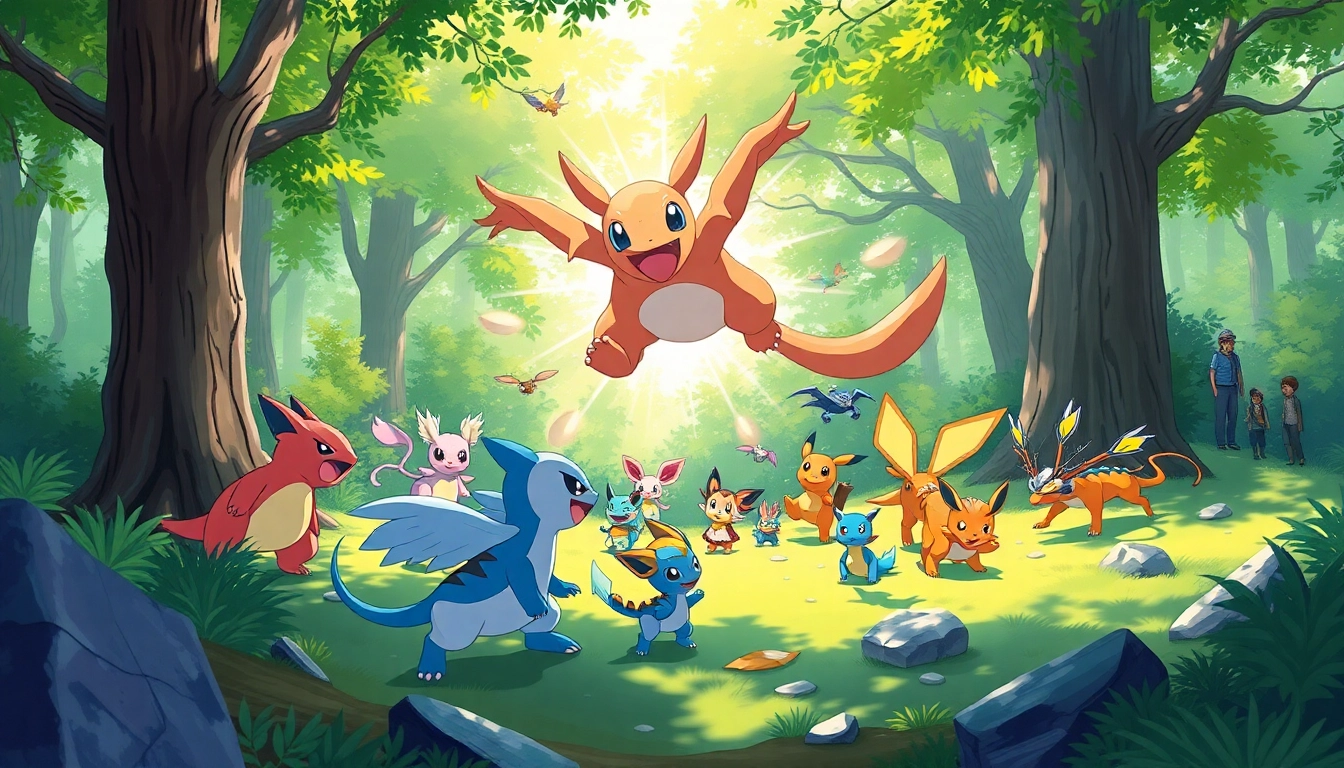Understanding the Pokémon Universe
Introduction to Pokémon Types and Abilities
The Pokémon universe is richly populated with a diverse array of creatures, each possessing unique types and abilities that significantly influence gameplay. At the core of this universe are the various Pokémon types, including Fire, Water, Grass, Electric, and more, each with strengths and weaknesses against other types. For example, a Fire-type Pokémon is strong against Grass-type Pokémon but weak against Water-type Pokémon. Understanding these mechanics is crucial for any aspiring Pokémon Trainer looking to build a formidable team.
Moreover, each Pokémon comes with distinct abilities that can turn the tide of battle. Abilities range from simple boosts in stats to complex effects that can hinder the opponent. Familiarizing yourself with both types and abilities is essential; it’s a foundational element of Pokémon strategy that allows trainers to make informed decisions about team composition and combat tactics. Consider exploring resources like pokemon for in-depth information.
Evolution: How Pokémon Grow and Change
Evolution represents a cornerstone mechanic within Pokémon, allowing certain Pokémon to transform into more powerful forms. This transformation is not just a aesthetic change; it often results in enhanced stats and new moves. Evolution typically occurs when specific conditions are met, such as leveling up, trading, or using special items. For instance, Charmander evolves into Charmeleon at level 16, showcasing how progression is integral to Pokémon development.
Understanding how and when to evolve your Pokémon can significantly influence your overall strategy. Some trainers prefer to delay evolution to keep the Pokémon at a certain level to learn specific moves. Others may choose to evolve as soon as they can to increase battle efficiency. Various evolution methods, such as Mega Evolution or regional forms exclusive to certain Pokémon, have also added new layers to this concept, presenting challenges and opportunities for trainers.
The Importance of Pokémon Moves and Techniques
Every Pokémon can learn a range of moves, each falling into categories like Physical, Special, or Status. Choosing the right set of moves for your Pokémon can make all the difference during a battle. Moves can be offensive, defensive, or supportive, allowing trainers to shape their team’s strategy. An understanding of move type dynamics, such as STAB (Same Type Attack Bonus), is vital for maximizing damage output.
The right moveset can also be pivotal in competitive play. Moves like Thunder Wave or Will-O-Wisp can inflict status effects that control the pace of battle. Moreover, trainers must consider coverage moves to handle various threats in the competitive environment. Analyzing popular moves and their usage in top-tier battles can provide valuable insights for trainers seeking to optimize their teams.
Preparing for Battle
Building Your Pokémon Team: Best Combinations
Creating a balanced Pokémon team involves more than just collecting strong creatures. A well-rounded team typically consists of Pokémon representing multiple types to cover their weaknesses and ensure diverse attacks. This strategy allows for adaptability during battles and makes it harder for opponents to counter your moves.
Trainers often use complementary roles when constructing a team. For instance, a core offensive unit could be supported by defensive Pokémon designed to absorb damage. Including Utility Pokémon, which can inflict status effects or set hazards, completes the team composition. By analyzing the strengths and weaknesses of potential team members, trainers can create dynamic combinations that maintain pressure on opponents.
Training and Leveling Up Strategies
Training your Pokémon efficiently is essential to ensure they are battle-ready. Leveling up can be achieved through various methods, such as battling wild Pokémon, participating in trainer battles, or utilizing items like Exp. Share. Each method has its advantages; for instance, battling trainers often yields more experience compared to wild encounters.
Moreover, trainers should consider utilizing breeding to create Pokémon with optimal stats, natures, and moves. Competitive battles often emphasize stat distribution and IV (Individual Values). Understanding how to manipulate these factors can help trainers develop better Pokémon for their teams. This area of training often involves significant planning but can pay off when preparing for tournaments or other competitive events.
Predicting Opponent Moves and Adjusting Tactics
Being able to anticipate your opponent’s moves is a crucial skill in Pokémon battles. This predictive ability can allow you to capitalize on your opponent’s strategy, making it crucial to familiarize yourself with popular Pokémon and their typical movesets. By understanding common trends and tactics, trainers can better prepare their own team compositions and move choices.
Practicing against various opponents, including both human players and AI, can enhance your predictive skills. Keeping a mental track of what Pokémon your opponent has already revealed and anticipating their counters can give you a significant tactical advantage. Ultimately, adjusting your tactics based on enemy behavior is key to achieving success in Pokémon battles.
Battle Mechanics Explained
Turn Order and Speed: What You Need to Know
One of the most pivotal mechanics in Pokémon battles is determining the turn order, primarily influenced by the Speed stat. The Pokémon with the higher Speed will usually act first, which can create opportunities to deal damage before the opponent can retaliate. Understanding this mechanic can allow trainers to prioritize which Pokémon to level up and can influence team dynamics.
Several factors, such as priority moves and status conditions (like paralysis), can also affect turn order. Trainers must be vigilant about how these factors interact. For example, using a move like Quick Attack will allow a slower Pokémon to strike first. By mastering turn order mechanics, trainers can control the tempo of the battle.
Understanding Type Matchups and Advantages
Type matchups are foundational to Pokémon battles. Each Pokémon type has specific strong and weak interactions with others. For instance, a Water-type Pokémon is particularly effective against a Fire-type Pokémon, but conversely, it’s at a disadvantage against an Electric-type. Mastery of type advantages allows trainers to leverage their Pokémon’s strengths while exploiting their opponent’s weaknesses.
In practical terms, this means that during a battle, your choice of which Pokémon to send out can significantly influence the outcome. For competitive players, type analysis is crucial for predicting the opponent’s next moves and making informed decisions, promoting a deeper understanding of battle strategies across different frameworks.
Status Effects: How They Can Turn the Tide
Status effects are powerful tools in battling that can turn the tide in your favor. Effects like Sleep, Burn, Paralysis, and Poison can substantially disrupt an opponent’s strategy. For example, Sleep has the ability to fully incapacitate a Pokémon for several turns, allowing a trainer to dominate the match without retaliation.
Trainers need to recognize both offensive and defensive status effects. For instance, moves like Toxic can be used to wear down an opponent slowly, while Heal Bell can be used to cleanse your team of detrimental status effects. By strategically applying and countering status effects, trainers can sway battles significantly, turning weaknesses into advantages.
Advanced Strategies for Competitive Play
Countering Popular Pokémon: Tips and Tricks
Every competitive metagame has its set of dominant Pokémon. Learning to counter these widely used creatures is essential for any competitive trainer. Pokémon like Garchomp, Dragapult, and Corviknight have distinctive strengths that allow them to thrive, making it important to develop strategies to counteract their advantages.
By equipping your Pokémon with specific moves or items, you can create counters. For example, using Ice-type moves against Garchomp significantly hinders its performance. Keeping track of meta shifts is essential; as new Pokémon are introduced, their presence may affect the viability of established team compositions and strategies.
Utilizing Items and Effects Wisely in Battle
Items play an invaluable role in Pokémon battles, offering significant advantages if applied correctly. Items range from consumables, like Potions, to battle-specific items, like Choice Specs or Leftovers. Trainers need to analyze when and how to use these items effectively. For instance, equipping a Pokémon with a Focus Sash can allow it to withstand a lethal attack once, providing a strategic opportunity to retaliate.
Moreover, understanding which items complement your team’s composition can lead to a well-rounded approach to battle. Utilizing abilities that pair well with held items, such as setting up with boosts before deploying items for optimal effect, can enhance performance and improve survivability.
Analyzing Tournament Strategies and Play Styles
Each Pokémon tournament presents its unique challenges and playstyles. Observing how top players execute their strategies can offer valuable insights into advanced play. Competitive tournaments often showcase a range of playstyles, from hyper-offensive approaches to more defensive tactics focused on longevity.
By watching replays and commentary from these tournaments, trainers can gather information on trending strategies and popular team compositions. Learning how to adapt and innovate upon these strategies can greatly enhance performance in battles against various opponents.
Resources to Enhance Your Pokémon Journey
Recommended Tools for Battle Preparation
Preparing for battle requires the right tools. Several online resources and databases like Smogon or Pokémon Showdown can help trainers optimize their team compositions, analyze movesets, and simulate battles. These platforms allow trainers to test strategies in a risk-free environment, providing a significant competitive edge.
Additionally, mobile applications and software that manage team building and provide real-time updates about Pokémon mechanics and attributes are great resources that can aid intensive preparation for future battles.
Where to Find Online Communities and Guides
Connecting with fellow Pokémon enthusiasts is beneficial for personal growth and strategy development. Numerous online forums, social media groups, and dedicated Pokémon communities offer a wealth of knowledge. Participating in these communities allows trainers to share experiences, get advice, and discuss various battle techniques with others who share the same interests.
Websites and platforms like Reddit, Discord, and various forums present a chance to connect with experienced players. These platforms often have guides, tips, and discussions regarding competitive play that can enhance a trainer’s skills.
Upcoming Pokémon Events to Participate In
Engaging in Pokémon events is a fantastic way to put your skills to the test and connect with other trainers. Tournaments, online competitions, and community days provide excellent opportunities to showcase your capabilities. Websites often announce upcoming tournaments, making it easier than ever to participate and gain experience.
Staying updated with the Pokémon community through official channels and social media could provide insights into special events or collaborations. Participating in these events not only builds skills but also expands the network of fellow trainers that may prove invaluable throughout one’s Pokémon journey.

